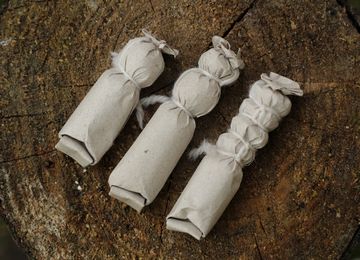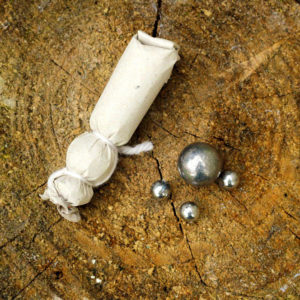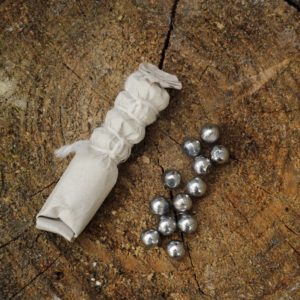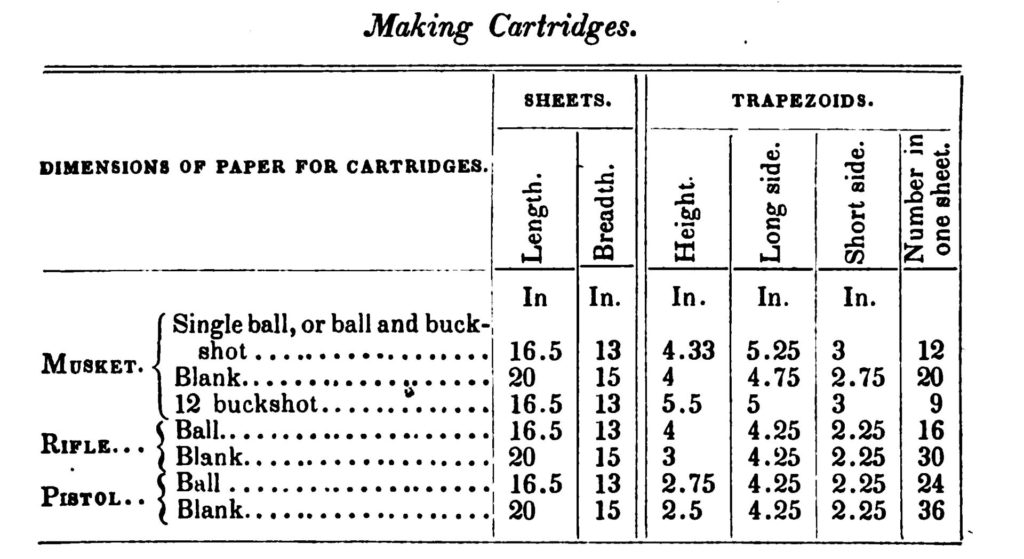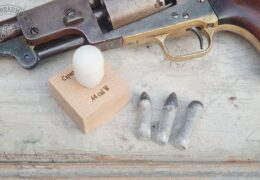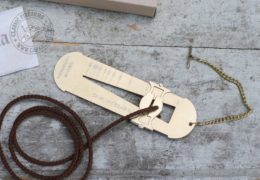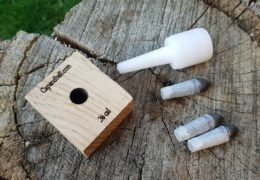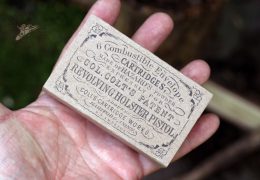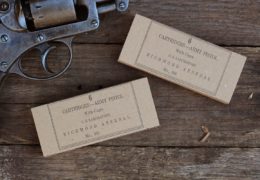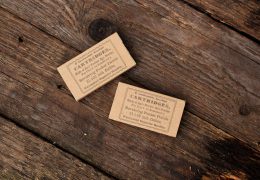.69 ball, buck and ball and buckshot cartridges of the U.S. Army

The construction of cartridges was standardized in the U.S. Army in the year of 1835. Since that time the ball cartridge construction followed the same pattern until they disappeared from the Ordnance manuals in 1861. Let’s follow the words of the 1841 U.S. Ordnance manual to get closer to the time of musket balls.
The flints
Selecting the right size, form and quality flint for a musket is a key factor if we want our shots to go off. We, target shooters know that, but we inherited this knowledge from the soldiers of the old times:
“The best flints are translucent with a smooth surface of a uniform tint of light yellow or brown color and slightly conchoidal fracture. They are generally obtained from England or France. The parts of a flint are the edge or bevel the back the sides the face slightly convex and the bed or lower face slightly concave in using the flint the bevel is placed uppermost There are three sizes for military service musket rifle and pistol flints A good musket flint will last for more than 50 fires Flints are issued to the troops in the proportion of 1 to 20 rounds.”
| DIMENSIONS of gunflints[1] | Musket | Rifle | Pistol | |||
| Min.
Inch |
Max.
Inch |
Min.
Inch |
Max.
Inch |
Min.
Inch |
Max.
Inch |
|
| Whole length: | 1.20 | 1.50 | 0.97 | 1.20 | 0.93 | 1.10 |
| Width: | 1.08 | 1.13 | 0.79 | 0.88 | 0.83 | 0.92 |
| Thickness at the back: | 0.26 | 0.33 | 0.20 | 0.29 | 0.21 | 0.27 |
| Length of the bevel: | 0.39 | 0.55 | 0.41 | 0.71 | 0.30 | 0.42 |
Each firearm required its own size that was checked with gauges. The flints were inspected and stored in barrels or boxes. One standard box held 5000 flints.[2] It was advised to store the boxes containing flints in the basement where the air was dump and cool.[3] The soldier was not allowed to snap the lock with the flint in the jaws. In fact, for practice he had to remove the flint and replace it with a wooden dummy or “snapper”. The flint was secured between layers of lead sheets, called the “flint cap”. If the flint became blunt, the soldier had to resharpen its bevel. For this process he had to turn the flint in the jaws to the “bevel up” position.
The powder
The gunpowder was manufactured in the traditional way. The same methods that were used in Europe by these times. Only two – but very similar – portions of ingredients are described. The ingredients were prepared in pounding mills, rolling barrels. After the consistent mix is achieved the powder was moistened and pressed into cakes with high pressure. After drying these cakes were crushed into grains. These grains were than separated by size by a series of sieves. The grains were glazed to resist moisture and shaking during transportation. Before barreling the powder was dried again. The final phase was the dusting which separated the small grains and powder from the gunpowder ready to be used.
The powder charge of the standard musket ball cartridge was 130 grains of musket powder, but when the majority of the muskets were converted to percussion locks the charge was reduced to 110 grains. There were two reasons to do this. First the flintlock ignition is not as fast as the percussion lock. The flames of the cap can ignite nearly the complete charge in the breech, therefore results a higher gas pressure and higher muzzle velocity with the same load. Second loading the flintlock musket started with pouring 6-12 grains of powder in the priming pan of the lock, that was not necessary for the percussion arms.
| Type of cartridge[4] | Ball | Powder charge | Remarks | ||||
| Dia. | Per pound | Weight | Per pound | Weight ratio | Blank cart. | ||
| Musket | 0.65 | 17 | 110 | 64 | 1/4 | 75 | Musket powder |
| Musketoon | 0.65 | 17 | 75 | 93 | 1/5 | 75 | |
| Hall carbine | 0.525 | 32 | 75 | 93 | 1/3 | 60 | Rifle powder |
| Rifle | 0.525 | 32 | 75 | 93 | 1/3 | 60 | |
| Pistol | 0.525 | 32 | 30 | 233 | 1/7 | 30 | |
The cartridges were loaded with musket or rifle powder. The musket and musketoon cartridges used musket powder, while the Hall carbines, muskets and rifles, common rifles and pistols used finer granulation rifle powder.
Casting the balls
The musket balls, according to the 1841 Ordnance manual were casted. The casting was done with hand molds, or clever devices like the circular molding machine invented by Daniel Pettibone in 1818 that was capable of casting 100.000 bullets a day as advertised by the maker. It utilized 8 pieces of 10 cavity musket ball molds. Two men were needed to operate it: one pouring the molten lead, one to turn the handles. It was capable of making 300 balls per minute. Pettibone offered the patent rights for the Army for 5000 USD, but the machine was forgotten for 20 years. When the rifle bullets were brought to use in 1838 the two machines lying in the arsenal at Charlestown were tested again. By this time the daily production of three men with traditional molds was around 8000 bullets. The repeated tests proved that the same 3 persons could make 75-99.000 bullets per a day.
The Pettibone molds were withdrawn from service after a short time as the arsenals replaced them with pressing machines. Even if the production method changed, the 1849 Ordnance manual still described the oldest way of making bullets:
“Weigh the lead; fill the kettle and cover it; as the lead melts add more, until it comes within 3 inches of the edge of the kettle; then cover it with a layer of powdered charcoal l in. thick; push the heat until paper in contact with the lead is inflamed by it; this requires from 1 to 2 hours.
Immerse the ladle and fill it about ¾ full of lead covered with charcoal, which is kept back with a piece of wood, in running the lead; fill all the moulds on one side, then turn them and fill the other side; the first castings are thrown back into the kettle, being imperfect from the moulds being cold; the diameter of some of the halls is verified from time to time, with the gauges; the moulds must be carefully cleaned when it is perceived that the lead sticks to them, and if any moulds give imperfect balls, they must be filled with copper. Extract the balls and trim them ;in cutting, the bull should be gently pressed with the left fore finger against the nippers, the gate being placed between the jaws.”
After the casting the balls were smoothed in rolling barrels or with just putting them in a bag and shaking them for five minutes. After smoothing the size of each ball was checked again:[5]
„Put 100 lbs. of them into the rolling barrel, and roll them for 3 minutes ; or 50 lbs. into a bag and shake it five minutes ; then run them through the screen, putting in 50 lbs. at a time ; those which remain on the screen are re-cast. With the above force 30,000 to 35,000 musket balls are made in 11 or 12 hours. With proper care in observing the instructions, 100 lbs. of lead will give from 96 to 98 lbs. of balls.”
Making the cartridges
The construction of the cartridges was completely done by hand. Usually one worker was responsible for one stage of the production. A 19 men group was working under the supervision of the master: 10 to roll the cylinders, 1 to fill them, 4 to fold, 4 to bundle. The manual suggests to use 12-18 age boys for these jobs. The buck and ball and single ball cartridges were suggested to be bundled together: 5 buck and ball cartridges accompanied by 5 single ball cartridges in a pack. A team like this could be capable of making 10.000 musket cartridges in a 10-hour work shift. But let’s see the complete process:
“Take the paper in the left hand, the former in the right; lay the paper on the table the side perpendicular to the bases towards the workman, the broad end to the left; place the former with its convex end at the broad end of the paper; tum it so to envelop it with the paper; then with the left hand laid flat upon the paper, roll all the paper upon the former; seize it with the left hand, and with the in the choking string in the right hand, take one turn around the cylinder at about half an inch from the end, to which distance the end of the former is withdrawn; hold former firmly in the left hand, and draw gently upon the choking string, pressing at the same time, with the left fore-finger, upon the projecting end of the cylinder, thus folding it neatly down upon the end of the former. Having choked the cylinder, carry it to the right side, and with the twine in the right hand, take two tums and a half hitch firmly around the part that has been choked; withdraw the former and introduce the ball, following it to the end of the cylinder with the former reversed; raise the whole again, and with the same thread, (which is never cut until the cartridge is finished) take two half hitches just upon the upper side of the ball, between it and the concave end of the former; the operation is expedited by rolling the ball placed in the concave end of the former and choking the paper over it. Cut the thread and place the cartridge in the box which stands fronting the workman.
For ball and buckshot cartridges. Roll and choke the paper, put in 3 buckshot, follow them with the former, and take a half hitch of thread over them; then insert the ball as before.
Buckshot cartridges have 4 tiers of 3 buckshot each, inserted like the first, with a half hitch between them and finishing with a double hitch.”
The buckshot cartridges utilized a different paper size. The 12 .30 caliber balls required a larger paper sheet to roll the cylinder, so the height of the trapezoid was 5,5”, long side 5” and the short side 3”.
The cartridges were boundled in waterproofed 8”x10” wrapping papers holding 10 cartridges in two tiers. 5 single ball cartrdiges were usally packed with 5 buck and ball cartridges.
The effectiveness of the buck and ball cartridges
In 1837 experiments were made at West Point to determinate the penetration of the available cartridges. The target was a target made of seasoned white oak. The penetration of the single ball propelled by 134 grains of musket powder was 1.6” at 9 yards, 1” at 100 yards and 0.55” at 200 yards. The penetration of the buck and ball was only measured at 9 yards with the result of 1.15” penetration for the ball and 0.41” for the buckshot. The heavier weight of the projectile reduced the muzzle velocity, therefore the kinetic energy of the ball, this is why the penetration was smaller. But still buck and ball the cartridges had devastating effect at close ranges against close battle formations.
Loading these cartridges were done the same way as the single ball cartridges. However the soldier had the option to choose which way to load the balls. In 1848 officers in the Watervilet Arsenal carried out some experiments with these cartridges They found that if the buckshot was between the powder and the ball the ball was more accurate but the buckshot scattered wider than if it was on top of the ball.
The buck and ball cartridges of the civil war
The construction instructions for making buck and ball and buckshot cartridges were eliminated from the civil war time ordnance manuals. However, the .69 cal single ball and the -69 buckshot cartridge are still listed in the table summarizing all standard issue cartridges in the 1862 Ordnance manual. Some minor changes can be noticed here: first the size of the ball was increased from .64 to .65 cal and the powder charge reduced to 110 grains of musket powder for the reasons mentioned before. The size of the single ball cartridge paper remained the same regardless of the smaller volume of the powder.
The ball cartridges had an advantage compared to the modern Minié bullets. The muzzle velocity of the obloseta roundball was much higher than the skirted elongated bullets’ velocity. A standard 510 grain Minié bullet propelled by a charge of 60 grains of musket powder was not more than 300 m/s (900 fps). The round ball fired from a smooth bore musket with the service powder charge left the bore above 400-420 m/s (1200-1260 fps). In close ranges this resulted a higher kinetic energy. But it must be stated that the inferior ballistic form of the roundball also resulted a much faster loss of velocity and energy, than the the elongated ball.
The balls of the .69 caliber cartridges were so undersized so they can be loaded easily even after many shots, when the bore was already fouled. Therefore there was no lubrication on these cartridges. The principle was simple, but still in many occasions the soldiers complained as the ball was hard to ram down after a few shots. This process was so hard that some soldiers drove the rammers against the trunk of trees to push down the started bullets.
The average shooting distance was well within the effective range of the old smooth bore muskets, especially in the first years of the war. Nor the officers nor the soldiers received proper training to take advantage of the accurate long-range fire of the rifle musket. The volleys were fired from a distance where it was possible to see the white of the eye of the enemy. Within this 100 yard distance the effectiveness of the rifle musket was not more than the effectiveness of the smooth bores. In fact, the buck and ball loads proved more effective in many occasions. The Irish Brigade chose to keep their U.S. 1842 muskets, and used them with deadly effect at the battle of Antietam, or at Gettysburg. The buck and ball was a better choice also when the untrained soldier felt the first stress of the battle and had to aim and fire rapidly through heavy smoke on an enemy advancing fast. Stopping a cavalry charge with single ball or Minié bullet is much harder than firing a volley with muskets loaded with buck and ball.
The situation was different if the enemy was further than 100 yards or it did not advance in closed masses. The rifle musket was a much better choice against enemy skirmishers. Members of the Irish Brigade also traded their smooth bores for rifle muskets while advancing at Antietam.
The deadly effectiveness of the buck and ball fired at close targets in unquestionable. However, let’s not forget that you do not have to kill the enemy. A serious wound can be as “useful”, because the injured soldier will draw at least one more healthy soldier from the battle to take him to the hospital. The pain and suffer of the wounded will also discourage and frighten the enemy. So even if the buckshot’s ability to kill drops significantly above 100 yards, it can still be tactically effective.
Balázs Németh
BIBLIOGRAPHY:
Dean S. Thomas: Round ball to rimfire Vol. 1
1841 Ordnance manual
1861 Ordnance manual
U.S. Patent 3140X D. Pettibone Mode of casting balls and shot of lead
Joseph G. Bilby: Small arms at Gettysburg
Joseph Bilby: Civil War Fireamrs
Earl J. Hess: The rifle musket in civil war combat
[1] Ordnance Manual 1850 p242
[2] Ordnance Manual 1850 p242
[3] Ordnance Manual 1850 p243
[4] Ordnance Manual 1850 p243
[5] Ordnance Manual 1850 p245

